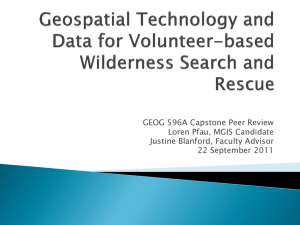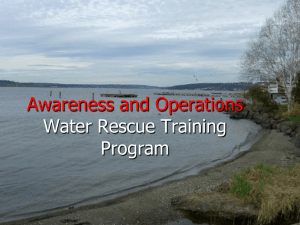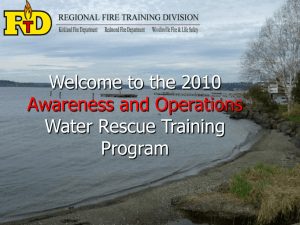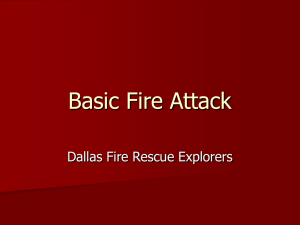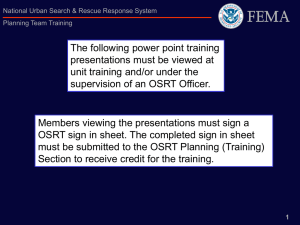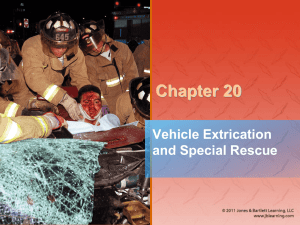Wilderness Search and Rescue Awareness
advertisement
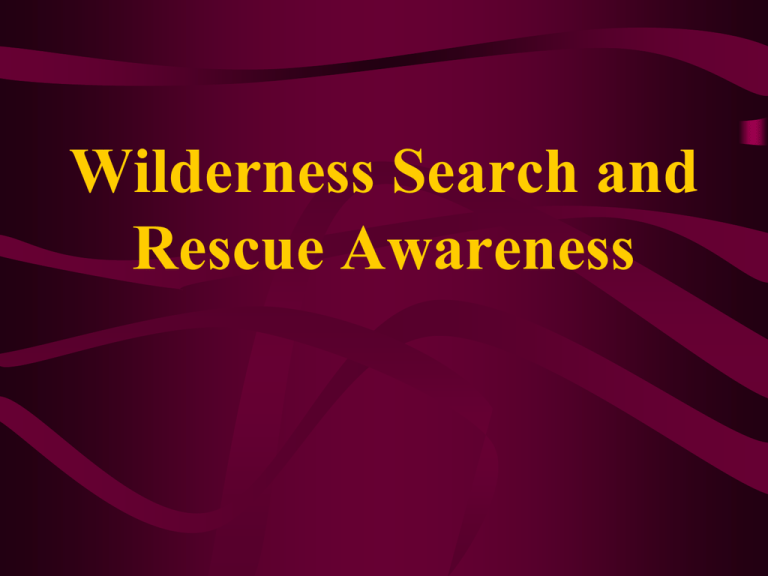
Wilderness Search and Rescue Awareness The following power point training presentations must be viewed at unit training and/or under the supervision of an OSRT Officer. Members viewing the presentations must sign a OSRT sign in sheet. The completed sign in sheet must be submitted to the OSRT Planning (Training) Section to receive credit for the training. Definition of Wilderness Search and Rescue What is it anyway? What is Search and Rescue • SEARCH To locate persons in distress • RESCUE Is the operation to retrieve persons in distress, provide for their initial medical or other needs, and deliver them to a place of safety The hope is a Successful Search will result in a Successful Rescue How Do You Fit In? “Finding and Aiding People in Distress; Relieving Pain and Suffering in All Its Many Forms.” Typical Missing Persons Incidents • • • • • Missing Hunters Missing Hikers Missing Alzheimer's/Dementia Abductions Missing Fishermen, Swimmers, boaters (Water Searches) • Missing from Motor Vehicle Accidents (runners) Typical not thought of incidents • Intoxicated wanders • Urban Search and Rescue or Technical Rescues due to: - Building Collapses - Confined Space - Trench - Mud Slides - Tidal Waves Four Elements of Wilderness SAR Discusses search and rescue organization, resources, methods, and techniques used in, and by federal agencies The federal role is one of coordination and intermediary between local, state and federal agencies State Responsibilities • All states have established enabling legislation which provides for direct support to local government entities during times of emergency or life threatening situations • Ohio Emergency Management State Resources • State resources that could be and have been used in Ohio - National Guard Helicopters - National Guard Ground Pounders - State Patrol Aircraft - DNR Aircraft - DNR Manpower and Equipment (boats etc.) Local Responsibilities • Ohio – SAR missions both on land and on inland waterways - responsibility falls under the authorization of the County Sheriff’s - Can provide resources and manpower of any type - Pass authority on to local Police, Fire or County Emergency Manager, for particular cases. Ohio Search and Rescue Pre-Planning • Know your Resources!!!! • Know your Hazards!!!! Resources • Refers to a person, group, or piece of equipment that has the ability to contribute to an operation or organization • A single person is termed an “individual resource.” • A collection of individuals and their equipment are called “group resources” Resources • Categorizing SAR resources consist of three basic subdivisions: – Human and animal – Informational – Equipment and technology Resources • Three types of human search resources – Hasty teams – Grid search crews – Human trackers • Each has its own uses, benefits, and limitations. Hasty Teams • Hasty teams are: – – – – – Small (usually 3 members) Well-trained Highly mobile Self-sufficient Clue conscious • Utilize fast, non-thorough search tactics in areas most likely to produce clues or the subject Hasty Teams • Should include individuals who are track aware, clue and subject oriented, and familiar with local terrain and dangers • Usually operate under standard operating procedures • Carry equipment to remain self-sufficient for 24 hours Grid Search Crews • Use vision to search well-defined, usually small, segment of land or water • Several individuals stand in a line and then walk together through the area. • Tight grid search teams – Perform either tight grid searches or evidence searches. – Objective is to search a segment to a high POD. Grid Search Crews • The objective in evidence search is to search in a very small area for inanimate objects. – Requires many searchers, often making it difficult to coordinate and manage – At least half of the team needs to be trained. – Any clues not discovered will likely be destroyed. Grid Search Crews • Loose grid teams – Similar to tight grid teams except may not maintain visual contact with adjacent searchers – Must have more skilled members – More independent than tight grid teams – Mix sound into their visual searches – Need to be self-reliant and skilled Human Trackers • Use their visual senses to search for evidence left by a person’s passing • Cut or look for sign by examining the area where the subject would likely have passed • Following the subsequent chain or chronology of sign is called tracking Human Trackers • Process of looking for the first piece of evidence from which to track is called sign cutting – Step-by-step method – Simple, methodical, and emphasizes finding every piece of possible evidence • Tracking is a very visual skill and requires a great deal of practice and experience Human Trackers Human Resources Con’t • • • • • • • Mounted Teams Rope Rescue Specialists Water Rescue Specialists Collapse Building Specialists ATV clubs Snowmobile clubs Amateur radio groups Resources Con’t • Explorer Groups • Psychics Animal Resources • Dogs • Horses Dogs • Dog teams consist of a dog and a handler • Two types of dogs used in SAR: – Tracking/trailing – Air scent • Each type differs in its approach to searching and its value depends on varying factors Dogs • Humans give off a constant stream of scent, like invisible smoke, made up mostly of skin cells • The cells, associated bacteria, and body secretions are detectable by a dog – Air scenting dogs detect the scent as it floats through the air – Tracking/trailing dogs detect the scent as it comes to rest on the ground Dogs • Tracking/trailing dogs – Frequently work on lead – Require a scent article to establish the scent • The ability of a handler to know when the dog is on the trail or has “alerted” to scent is acquired through many years of practice Horses • Primarily a means for transportation for equipment • Can search remote or rough terrain • Equestrian units can be damaging to terrain and evidence • In the right circumstances, horses can be a valuable asset Equipment and Technology • Aircraft – Can search from a greater distance, at a greater speed, over a larger area – Both a tactical tool and a mode of transportation Aircraft (Fixed Wing, Helicopters) - Auxiliary unit to United States Air Force - Provides the majority of response to downed or missing aircraft in the U.S. - CAP can provide a incident manager with mission coordinators; aircraft, pilots, and observers; ground search teams, base camp support; and communications Equipment and Technology • Specialized vehicles – – – – Over-snow Four-wheel drive All-terrain Mountain bikes Wilderness Search and Rescue Hazards • Terrain Hazards A.) Cliffs B.) Caves C.) Standing water (e.g. ponds, lakes) D.) Flat ice E.) Swiftwater F.) Snow G.) Significant obstacles H.) Mines I.) Wells Hazards • Environmental Hazards A.) Insect bites, and stings B.) Poisonous plants C.) Exposure injuries D.) Snow-blindness E.) Lighting F.) Dangerous wildlife Hazards • Man-made Hazards A.) Booby-Traps B.) Labs C.) Landfills D.) Trained attack dogs E.) Biological, Chemical, Radiological Weapons Hazards • Personal Medical Conditions Possible in SAR A) Blisters B) Scrapes C) Scratches D) Falls E) Blows F) Bruises G) Dehydration




